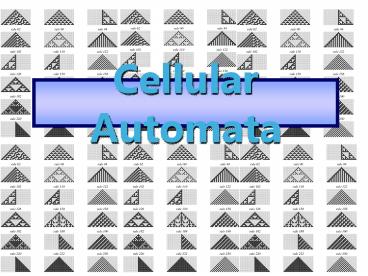Cellular Automata - PowerPoint PPT Presentation
Title:
Cellular Automata
Description:
It consists of a regular grid of cells, each in one of a finite number of states. ... gravely, and go on till you come to the end then stop. ... – PowerPoint PPT presentation
Number of Views:95
Avg rating:3.0/5.0
Title: Cellular Automata
1
Cellular Automata
2
Discrete Math
- A cellular automaton is a discrete model studied
in computability theory and microstructure
modeling. - It consists of a regular grid of cells, each in
one of a finite number of states. - The grid can be in any finite number of
dimensions. - Time is also discrete, and the state of a cell at
time t is a function of the states of a finite
number of cells (called its neighborhood) at time
t - 1.
3
Dimensions
- A one-dimensional cellular automaton consists of
two things a row of "cells" and a set of
"rules". - Two-dimensional cellular automata use rectangular
grids of cells. - "CA"means "one-dimensional cellular automaton.
4
States of Automata
- Each of the cells can be in one of several
"states". The number of possible states depends
on the automaton. Think of the states as colors.
In a two-state automaton, each of the cells can
be either black or white. Of course, you might
just as easily use purple and orange to represent
the states, if you thing that's prettier. In a
three-state automaton, the states might be black,
red, and blue.
5
Rules over Time
- A CA doesn't just sit there. Over time, the cells
can change from state to state. The cellular
automaton's rules determine how the states
change. It works like this When the time comes
for the cells to change state, each cell looks
around and gathers information on its neighbors'
states. You should think of the row of cells as a
miniature "world" that runs through a sequence of
"years" or "generations." At the end of each
year, all the cells simultaneously decide on
their state for the next year.
6
- http//www.bitstorm.org/gameoflife/
The Rules For a space that is 'populated' Each
cell with one or no neighbors dies, as if by
loneliness. Each cell with four or more
neighbors dies, as if by overpopulation. Each
cell with two or three neighbors survives. For a
space that is 'empty' or 'unpopulated' Each cell
with three neighbors becomes populated.
7
Examples
- The White Rabbit put on his spectacles.
- Where shall I begin, please your
- Majesty?" he asked.
- Begin at the beginning," the King said, very
- gravely, and go on till you come to the end then
stop." - Lewis Carroll, Alice's Adventures in Wonderland
8
Self Replication
- http//en.wikipedia.org/wiki/Von_Neumann_cellular_
automata - Chou-Reggia loop
- Codd's cellular automaton
- Evoloop
- Langton's loops
- SDSR loop
- von Neumann's Universal constructor
- Asynchronous cellular automaton
9
Continuous Automata
- There are continuous automata. These are like
totalistic CA, but instead of the rule and states
being discrete (e.g. a table, using states
0,1,2), continuous functions are used, and the
states become continuous. The state of a location
is a finite number of real numbers. Certain CA
can yield diffusion in liquid patterns in this
way.
10
(No Transcript)
11
Moore Neighborhood
- In two dimensions, with no threshold and the von
Neumann neighborhood or Moore neighborhood, this
cellular automaton generates three general types
of patterns sequentially, from random initial
conditions on sufficiently large grids,
regardless of n. - For larger neighborhoods, similar spiraling
behavior occurs for low thresholds, but for
sufficiently high thresholds the automaton
stabilizes in the block of color stage without
forming spirals. - At first, the field is purely random. As cells
consume their neighbors and get within range to
be consumed by higher-ranking cells, the
automaton goes to the consuming phase, where
there are blocks of color advancing against
remaining blocks of randomness.
12
mathworld.wolfram.com/CellularAutomaton.html
http//www.cs.bgu.ac.il/sipper/papabs/epcm.pdf
http//en.wikipedia.org/wiki/Cellular_automatonS
elf-replication_in_cellular_automata
http//en.wikipedia.org/wiki/Belousov-Zhabotinsk
y_reaction http//math.hws.edu/xJava/CA/
13
(No Transcript)
14
Patterns
- Patterns produced by the parity rule, starting
from a 20 20 rectangular - pattern. White squares represent cells in state
0, black squares represent - cells in state 1. (a) after 30 time steps (t
30), (b) t 60, (c) t 90, (d) - t 120.
15
Schematic Diagram
16
History
- Over the years they have been applied to the
study of general phenomenological - aspects of the world, including communication,
computation, construction, growth, reproduction,
competition, and evolution.
17
By Katherine Kulik































